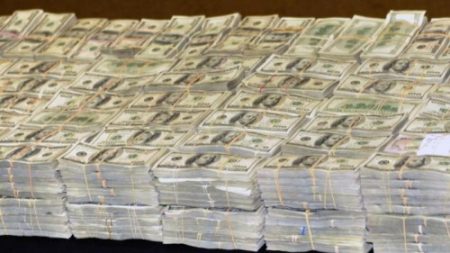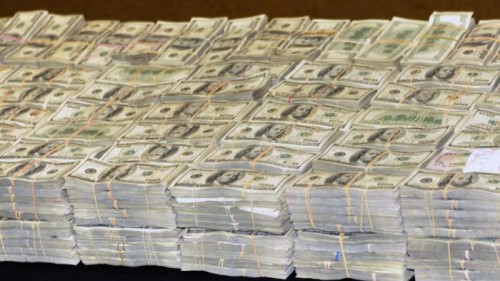Bloomberg reports that Mexico’s government is taking an unusual step to weather a U.S. money-laundering crackdown that threatens to hobble dollar-fueled businesses from Cancun hotels to Tijuana beauty salons: It’s getting into the dollar-transfer business.
The country’s central bank will soon unveil an electronic system designed to ease U.S. dollar transfers between Mexican businesses, said Banco de Mexico spokesman Ricardo Medina. The network will let businesses send U.S. currency to each other through a clearinghouse overseen by the central bank and moving through a bank in the U.S., according to a central bank official familiar with the program, who said the system could be introduced as soon as next month.
The move addresses a growing problem in Mexico: Several foreign banks have cut ties with Mexican counterparts in recent years. Bankers and officials in Mexico fear further barriers to financial flows between their country, Latin America’s second-largest economy, and the U.S., its biggest trading partner. Large swaths of Mexico’s $1.3 trillion economy rely on the dollar, from manufacturers in border zones such as Ciudad Juarez to travel-industry businesses in spots like Puerto Vallarta.
Transferring dollars through the U.S. has become harder, Mexican lenders say, after U.S. regulators and law enforcers cracked down on banks that didn’t flag transfers linked to Mexican drug cartels or other criminals. In recent years, international banks have paid more than $2 billion for lapses including the failure to flag suspicious dollar transactions between the countries. That has led other banks to sever ties pre-emptively — a process euphemistically known as “de-risking.”
The illicit drug trade in the U.S. generates $64 billion a year, according to an estimate by the U.S. Treasury Department, which calls Mexico the primary supplier or transit point for some drugs. But illicit-drug revenues pale in comparison with the $531 billion in legitimate trade between the two countries.
“Clearly, the U.S. government doesn’t want to drive banks into such de-risking activity that they can’t bank anymore with Mexico,” said Robert McBrien, a former associate director for global targeting at the U.S. Treasury’s Office of Foreign Assets Control. “You don’t want to wipe out that financial flow — you want transparency.”
No ‘Silver Bullet’
That’s where the central bank steps in. Banco de Mexico will oversee the transfer system and its relationship with a U.S.-based clearing bank that hasn’t yet been chosen, according to the central bank official, who asked not to be named because the program hasn’t been made public. In turn, the central bank will demand that banks using the system perform stepped-up vetting on their own customers and transactions, said the official. Mexican member banks will ultimately be held accountable for compliance, the official said.
The U.S. Treasury sees Mexico’s plan as a positive step. The Mexican government’s measures aren’t “a silver bullet in the heart of the drug cartels,” said Daniel Glaser, the U.S. Treasury’s assistant secretary for terrorist financing. “But it complements other steps we’re taking to undermine cartel finances.”
The Mexican plan presents a new approach to a frustration shared by banks across the globe, as stepped-up enforcement has made some of them skittish about partnerships they’ve formed to move money around the world. About half of the 110 banking authoritiessurveyed by the World Bank last year said the institutions they oversee had a decline in such correspondent banking relationships.
While Hong Kong and Canada have long operated their own dollar clearinghouses, Mexico’s would be unusual in that it would be lodged inside the U.S. banking system as a middleman for routing dollars between domestic parties.
The Client’s Client
Known by its Spanish acronym SPID, the central bank’s system will provide transparency and anti-money laundering controls, said Banco de Mexico spokesman Medina. “The goal is to simplify the requirement for U.S. banks to know their client’s client by earning correspondent banks’ trust that Mexico is correctly checking out those customers,” he said.
Currently, bank transfers that begin and end in Mexico account for about one-third of the funds moving between the two countries, according to a central bank survey. Much of that money is routed through U.S. correspondent banks, which stand to lose some business if the Mexican plan is successful.
Yet the status quo has also been costly for all sides. Businesses in Mexico have paid high fees for such transactions, which are often slowed by anti-money laundering scrutiny. In 2012, HSBC Holdings Plc agreed to pay a then-record $1.9 billion fine for issues including Mexican money-laundering lapses and sanctions violations.
More recently, Citigroup Inc. began closing Banamex USA, with branches in Texas and California catering to Mexican clients, after paying a U.S. fine related to money-laundering violations linked to the unit. Netherlands’ Rabobank Groep has also shut U.S. branches along Mexico’s border that were subject to a U.S. probe. Citigroup and Rabobank have said they’re cooperating with authorities. Representatives for the three banks declined to comment.
Dimon Meeting
Additional bank pullbacks have sent shock waves through Mexico. In 2013, JPMorgan Chase & Co. restricted some transactions tied to a Mexican bank, according to people familiar with the decision. Banco de Mexico Governor Agustin Carstens, in a meeting later that year with JPMorgan CEO Jamie Dimon, called the move a threat to Mexico’s financial system, according to two people with knowledge of the meeting. JPMorgan and the central bank declined to comment on the meeting.
Mexico has made other attempts to improve relations with U.S. banks and regulators. In 2013, U.S. and Mexican authorities agreed to exchange information to combat money laundering and terrorist financing. The following year, Mexico lifted restrictions on cash deposits for border businesses that allowed authorities to monitor transactions.
Last year, Promontory Financial Group LLC, which advises companies on regulatory requirements, began consulting with the Mexican Banking Association on how to improve members’ compliance programs, according to people familiar with the matter. A Promontory spokesman declined to comment.
While the program’s final rules and fee structure haven’t yet been published and banks haven’t yet been selected to participate, 25 Mexican lenders — all with access to a correspondent bank in the U.S. — are performing initial tests on the technology of the system, the central bank official said.
The new system won’t fully address the pullback of foreign banks, said Luis Robles, who leads Mexico’s banking association and is also the chairman of BBVA Bancomer SA. Mexican lenders still must convince U.S. counterparts that their anti-money laundering controls are strong, he added. “It’s a partial solution,” he said.
By Benjamin Bain and Alan Katz for Bloomberg Business
Source: bloomberg.com




1 comment
Dude, the US is on the verge of energy independence…..through fracking we now can produce more oil then the Saudi’s.
Comments are closed.